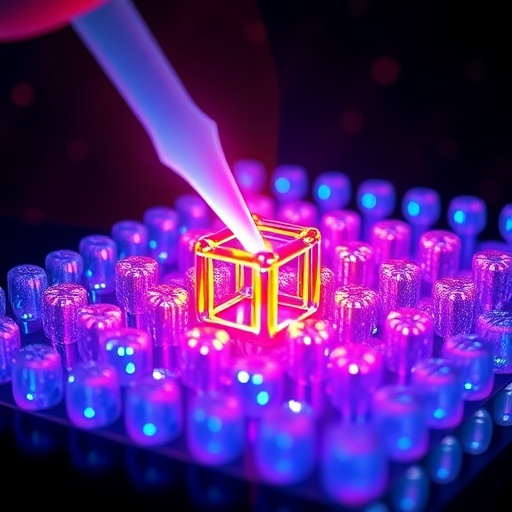
In the ongoing quest to bridge the gap between quantum phenomena and practical applications, a critical barrier has persisted: the fragile nature of macroscopic quantum coherence at ambient conditions. Traditionally, such quantum coherence and collective electronic states have been achievable only under stringent cryogenic environments due to rapid thermal dephasing processes. These processes, primarily driven by lattice vibrations and thermal motions within solid-state systems, dismantle the delicate quantum superposition states essential for novel quantum effects. However, a groundbreaking study now reveals an unprecedented mechanism by which these limitations can be overcome, enabling superfluorescent macroscopic quantum states to emerge robustly at elevated temperatures.
The research focuses on lead halide perovskites, an emerging class of materials well-known for their remarkable optoelectronic properties and facile fabrication. These materials present a complex interplay between electronic excitations and the crystal lattice, serving as a fertile ground for exploring cooperative quantum dynamics in solid-state systems. Unlike conventional semiconductor structures, where electron–phonon interactions generally disrupt coherence, lead halide perovskites demonstrate a remarkable capacity to harness these interactions, promoting rather than inhibiting collective quantum behavior under the right conditions.
Central to this breakthrough is the identification of spontaneously synchronized polaronic lattice oscillations that accompany the collective electronic dipole emission during superfluorescence. Polaronic effects typically describe the coupling of charge carriers with lattice distortions; here, this coupling forms a coherent pattern of lattice deformations that act synergistically with the electronic excitations. This discovery overturns the conventional view that lattice motions merely serve as a decoherence channel, instead positioning them as active participants in establishing long-range quantum order. Such a phenomenon suggests the formation of a new hybrid state, where electronic and lattice degrees of freedom become intricately entangled.
.adsslot_XtbhM7nryH{width:728px !important;height:90px !important;}
@media(max-width:1199px){ .adsslot_XtbhM7nryH{width:468px !important;height:60px !important;}
}
@media(max-width:767px){ .adsslot_XtbhM7nryH{width:320px !important;height:50px !important;}
}
ADVERTISEMENT
To fully comprehend the mechanisms at work, the researchers developed an effective theoretical field model describing the exciton–lattice interactions within the perovskite crystal framework. This model reveals a critical polaron density threshold beyond which the system undergoes a phase transition into an electronically and structurally entangled solitonic state. Soliton-like excitations are known in nonlinear systems for their ability to maintain stable, localized wave packets over extended distances. Their emergence in this solid-state environment indicates that the material can sustain coherent wave-like electronic states that are stabilized by the lattice structure itself, even at temperatures where thermal agitation would typically obliterate such order.
The phase transition described is highly nontrivial and involves two simultaneous and cooperative processes. First, incoherent and disordered polaronic lattice deformations spontaneously organize into a quasi-ordered structure, breaking the symmetry of the lattice in a subtle yet crucial manner. Concurrently, a macroscopic quantum coherence develops among the exciton population, creating a collective dipole moment that radiates coherently as superfluorescence. This dual ordering process establishes a novel state of matter where the usual antagonism between electrons and phonons is transformed into a unifying foundation for emergent quantum phenomena.
Remarkably, the recombination of excitons within this entangled solitonic phase culminates in the emission of intense bursts of superfluorescence at temperatures significantly above room temperature. Superfluorescence, characterized by the spontaneous and cooperative emission of light from a large ensemble of coherently excited dipoles, has traditionally been confined to low-temperature regimes due to the need for prolonged coherent lifetimes. This demonstration in lead halide perovskites marks a significant leap forward, presenting a viable route to integrating macroscopic quantum emitters into devices operable under ambient conditions.
This study also brings to light fundamental connections between transient non-equilibrium phenomena induced by impulsive excitation and equilibrium-like phase transitions achievable via thermal control. It suggests that the transient superfluorescence process observed immediately following pulsed photoexcitation shares deep theoretical parallels with phase transitions known from condensed matter physics, such as symmetry breaking and order parameter emergence. This insight enriches our conceptual understanding of how externally driven quantum systems traverse complex energy landscapes towards coherent states.
From a materials science perspective, the research highlights the necessity of precisely tuning electron–lattice interactions to favor collective coherence. Lead halide perovskites offer a versatile platform where multiple modes of electron–phonon coupling coexist, ranging from relatively soft lattice vibrations to more pronounced polaronic effects. The identification of which specific lattice dynamics facilitate solitonic coherence versus those that hamper it is critical; by selectively engineering the lattice environment and electron interaction parameters, new classes of quantum materials may be designed to sustain high-temperature macroscopic quantum states.
This paradigm-shifting work underlines the importance of including lattice dynamics not merely as environmental noise but as integral components capable of stabilizing exotic quantum states in solids. Consequently, it paves the way for future exploration of hybrid quantum states that exploit collective lattice-electronic phenomena for robust quantum technologies, including ultrafast coherent light sources, quantum information platforms, and sensors with enhanced sensitivity that function without the burdensome need for cryogenic cooling.
Furthermore, the discovery invites a reevaluation of long-standing assumptions regarding decoherence mechanisms in solid-state quantum systems. While thermal fluctuations have historically been seen as the nemesis of quantum coherence, the present findings suggest scenarios where the environment can be co-opted to foster synchronization and coherence, reminiscent of self-organizing principles observed in complex biological and chemical systems.
In practical terms, this research could accelerate the deployment of quantum devices based on perovskite materials, whose ease of processing and tunable properties already make them attractive for photovoltaics and light-emitting diodes. Embedding coherent quantum functionalities in such material platforms may yield unforeseen synergies, merging classical and quantum regimes with wide-ranging technological impact.
The theoretical and experimental frameworks established here open numerous avenues for probing the nature of electron–phonon entanglement, collective excitations, and their dynamic evolution in nonequilibrium conditions. Subsequent investigations are poised to explore the scalability of these solitonic superfluorescent states, their coherence times under varying thermal backgrounds, and their response to controlled structural modifications.
Overall, this study marks a milestone in materials quantum science by demonstrating that intricate electron–lattice coupling can catalyze the spontaneous emergence of macroscopic quantum coherence, heretofore confined to ultracold environments, now attainable at technologically relevant temperatures. Its implications resonate across condensed matter physics, quantum optics, and materials engineering, heralding a new era in the design of quantum functional materials.
Subject of Research: High-temperature macroscopic quantum coherence and superfluorescence in lead halide perovskites through exciton–lattice interactions.
Article Title: Unconventional solitonic high-temperature superfluorescence from perovskites.
Article References:
Biliroglu, M., Türe, M., Ghita, A. et al. Unconventional solitonic high-temperature superfluorescence from perovskites. Nature (2025). https://doi.org/10.1038/s41586-025-09030-x
Image Credits: AI Generated
Tags: collective electronic stateselectron-phonon interactionshigh-temperature superfluorescencelead halide perovskitesmacroscopic quantum coherenceoptoelectronic properties of perovskitespolaronic lattice oscillationsquantum dynamics in materialsquantum phenomena in solid-state systemsrobust quantum states at ambient conditionssuperfluorescence mechanism in perovskitesthermal dephasing processes





